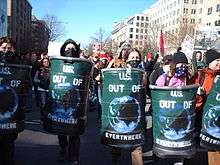Riot shield

Riot shields are lightweight protection devices deployed by police and some military organizations. Riot shields are almost exclusively long enough to cover an average-sized man from the top of the head to the knees. Some riot shields are designed to be bullet resistant against low-velocity handgun and shotgun ammunition; however, most are not. They are generally intended to be used in riot control, to protect the user from shrapnel, thrown projectiles, and splash from various weapons such as a Molotov cocktail. They can also be used as short-ranged melee weapons to push back rioters.
Riot shields are used in almost every country with a standardized police force and are produced by many companies. Most riot shields are constructed from transparent, high-impact polycarbonate to enable the bearer to see incoming thrown objects, so the shield can quickly be positioned to deflect them away from the user's body. Riot shields come in 3 defrost sizes round 4ft and6ft.
Varieties of riot shields


Riot shields can come in various shapes, including:
- Round. A common size is 60 cm in diameter.
- Rectangular with rounded corners, curved in the horizontal cross-section to shed thrown objects. A common size is 50 or 60 cm by 100 cm. Some are tall enough for the bottom edge to be put on the ground.
- The same, but also curved in the vertical cross-section at the top and bottom.
- There is a type of shield which is curved horizontally the "wrong" way, i.e. concave forwards. These are for handling an uncooperative prisoner or suspect in a cell or small room.
- Some shields are "ballistic", i.e. strong enough to resist firearms fire.
Handle arrangements include:
- A common type is two large, vertical handles at the same level: the user puts an arm (usually the left arm) through the arch of one handle and holds the other handle.
- This image shows another type: the middle of the shield is built up at the back, with two valleys crossing in X shape, and a grab handle in a hollow at the top end of each valley, and a forearm-restrainer arch astride each valley below the crossing. The user puts one forearm along one of the valleys, grasping the handle at its top. (This allows use with either arm.) This spreads the load of a heavy impact on the shield front more effectively across the user's forearm. (For two-handed use, the other hand could grasp the unused forearm-restrainer arch.)
- A tall, rectangular riot shield can have three handles: the first type of two handles, and also a small third lower handle for two-handed holding if a firmer grip is needed (e.g. for pushing rioters or demonstrators back).
A type that must be held in both hands does not let the user use a baton or gun in the other hand.
Riot shields are commonly used for protection from thrown projectiles or blunt/edged weapons, but not firearms. Ballistic shields are commonly known by the brand names "Body Bunker" and "Baker Batshield".
The extremely lightweight "Baker Batshield" ballistic shield is popular for police patrol first responders utilizing progressive "Immediate Action Rapid Deployment" (IARD) tactics when approaching high-powered handgun, shotgun or submachine-gun threats.
"Body Bunker" ballistic shields are opaque with a small, clear, armored sight window and commonly have a bright light mounted on the frontal surface. Bunker shields are not normally used by riot police, but more often tactical SWAT teams, as they are bulky, heavy, and designed to be used during slow, methodical operations where there is a higher risk of the officers being shot at.
Tactics

Ballistic shields
In a dynamic entry situation, a team of special police (such as SWAT) try to clear a room quickly and decisively. For example, one member would smash the door open with a battering ram, then step aside as the first team member wielding the shield entered the room and protected the door. The other team members would enter behind him and take control of the room.
Tactics
Riot control tactics vary between different police and military forces the world over. Generally, riot shields are intended to protect the user from thrown objects and projectiles and interlinked with others to form a physical barrier against rioters/protesters etc. However, they are also used to push protesters back, and in some cases, can be used as short-range weapons against threats to the shieldbearer.
There have been cases of demonstrators imitating police shield tactics, as in the image on the right. The people in the image on the right have most likely divided road safety barrels, put handles on them, and covered the top edge with foam pipe insulators. See also , ,.
Construction
Most are a clear polycarbonate or multilayer Lexan weaves. These polycarbonate shields are generally made on polymer looms such as the RLCB30. Some shields are constructed of light metals with a view hole integrated into the design.
See also
External links
| Wikimedia Commons has media related to Riot shield. |